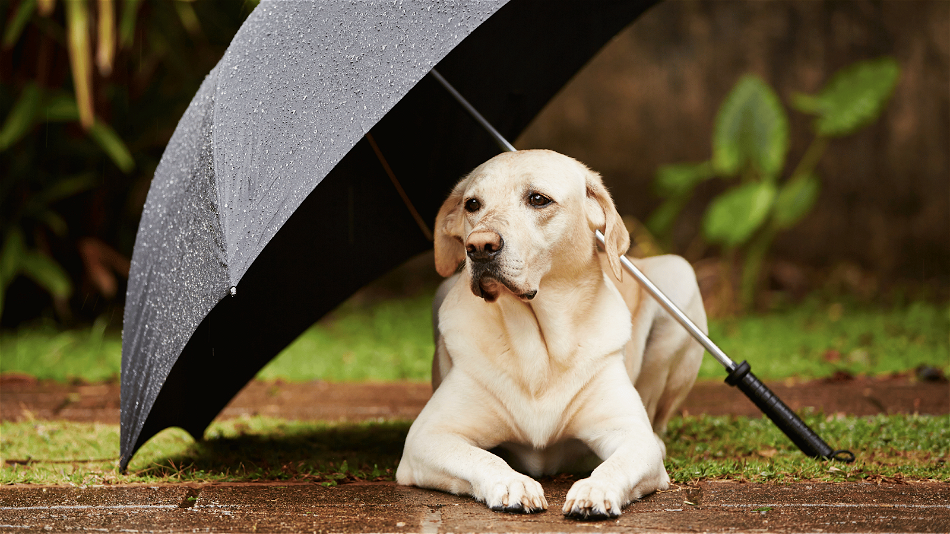Dogs have always amazed us with their remarkable senses. They can detect medical conditions, drugs, and even emotions that humans can’t. But can dogs sense bad weather or predict when a storm is coming? Many dog owners believe so, citing their pets’ restless behavior or anxiety before a storm. So, is there any scientific evidence to support these claims? Let’s uncover the truth behind dogs’ ability to sense storms.
How Dogs Know When Bad Weather or Storms are Coming
What is Barometric Pressure?
Barometric pressure refers to the weight of the atmosphere above us and is associated with changes in weather conditions. Low-pressure systems are often linked to bad weather, while high-pressure systems indicate clear and sunny weather.
How Do Dogs Sense Barometric Pressure?
While the exact mechanism remains unclear, dogs’ acute hearing and smell may allow them to perceive changes in barometric pressure. Their heightened senses enable them to detect shifts in static electricity or catch the distant scent of rain before humans can. Some researchers even believe that dogs have specialized receptors sensitive to atmospheric pressure changes.
Research has shown that barometric pressure affects odors for search and rescue dogs, suggesting that dogs may have a change in their olfactory perception when the weather changes. These physical sensations, such as pressure in their ears, might alert them to impending bad weather.
Role of Static Electricity & Why Dogs are Scared of Storms
Another theory suggests that dogs can sense changes in static electricity caused by thunderstorms. The buildup of static electricity can make the air feel charged, causing dogs to feel anxious or restless. Thunderstorms generate a significant amount of static electricity, and dogs may seek places with less static electricity during a storm.
Dogs Can Smell Rain (Petrichor) and Chemical Changes In The Air
Dogs’ extraordinary sense of smell plays a crucial role in their ability to sense bad weather. Their sense of smell is estimated to be between 10,000 to 100,000 times more sensitive than humans’. They can detect scents at extremely low concentrations, enabling them to sense chemical changes in the atmosphere.
The Smell of Lightning and Atmospheric Changes
Lightning can significantly alter the chemical composition of the air. As lightning strikes, it heats the air, breaking the bonds between molecules and rearranging them. This process creates ozone, which has a distinct smell humans can detect at low concentrations. Dogs, with their advanced olfactory abilities, can likely detect this smell even before humans can.
The Smell of Petrichor
Petrichor is the earthy scent produced when rain falls on dry soil. Dogs can detect this smell produced by certain plants and minerals in the soil, even before humans can. Their ability to perceive these scents adds another layer to their remarkable sense of smell.
Dogs Can Hear Sounds Further Away (Like Tornadoes or Thunder)
Dogs’ acute sense of hearing allows them to detect sounds that are beyond the range of human perception. While humans can hear thunder up to about 10 miles away from the lightning strike, dogs can perceive low-frequency rumblings of a distant storm long before we can.
Dogs have better motion visibility and may be more aware of distant lightning
Dogs have better motion visibility than humans, enabling them to detect distant lightning or even faint flashes that humans may miss.
Dogs Can be More Sensitive to Changes in Their Environment (and Us)
Dogs are highly attuned to their environment and may be more sensitive to changes in the atmosphere than humans. They can also sense changes in our behavior, making them aware of approaching storms even before they occur.
Dogs Can Make Pair Associations With Early Signs Of Storms From Experience
Dogs are intelligent animals capable of learning from experience. They can make associations between early signs of a storm, such as drops in barometric pressure or changes in the air, and the onset of bad weather.
How Dogs React to Bad Weather
Behavioral Changes
Dogs may exhibit behavioral changes when bad weather is approaching. Restlessness, pacing, whining, and seeking comfort from their owners are common behaviors. Some dogs may develop noise phobia, showing symptoms such as shaking, panting, and hiding.
Physical Reactions
Dogs may also experience physical reactions to bad weather. They may become lethargic, lose their appetite, or have digestive issues. Dogs with joint problems or arthritis may experience increased pain and stiffness during changes in barometric pressure.
How to Help Your Dog During Bad Weather
Creating a Safe Space
Ensure your dog has a comfortable and secure space to retreat to during bad weather. This could be a crate, a designated room, or a cozy corner with their favorite blanket. Consider using a thunder jacket or calming supplements to alleviate their stress.
Training and Conditioning
Training your dog to be comfortable with thunder and lightning from a young age can help them manage their fear. You can gradually expose them to recorded thunder sounds and associate them with positive experiences. Regular exercise and conditioning can also help dogs cope with bad weather.
Frequently Asked Questions
Conclusion
Dogs possess extraordinary senses that allow them to detect changes in the environment, including bad weather. Their exceptional sense of smell, hearing, and motion visibility enables them to sense approaching storms and react accordingly. While the scientific understanding behind their abilities is still evolving, there is no doubt that dogs have a remarkable knack for sensing bad weather. As our faithful companions, they offer us a unique perspective on the world around us.
To learn more about dogs and their amazing abilities, visit Pawsoha.

